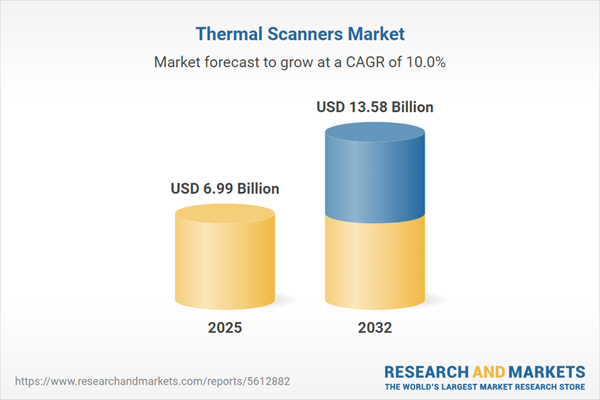Speak directly to the analyst to clarify any post sales queries you may have.
The thermal scanners market is transforming operational protocols across security, healthcare, and industrial sectors. As organizations seek advanced, real-time temperature and imaging solutions, decision-makers require comprehensive insights into evolving technologies, risks, and opportunities shaping this market.
Market Snapshot: Global Thermal Scanners Market
The Thermal Scanners Market grew from USD 6.34 billion in 2024 to USD 6.99 billion in 2025. It is expected to continue growing at a CAGR of 9.98%, reaching USD 13.58 billion by 2032. Spanning applications such as border security, medical diagnostics, and industrial maintenance, thermal scanners are becoming integral for risk mitigation, compliance, and process optimization.
Scope & Segmentation
- Type: Fixed, Handheld
- Technology:
- Cooled Thermal Detectors: Indium Antimonide, Mercury Cadmium Telluride
- Uncooled Thermal Detectors: Microbolometer
- Application:
- Automotive Testing: Performance Testing, Quality Control
- Firefighting: Fire Rescue, Wildfire Detection
- Healthcare: Fever Screening, Patient Monitoring
- Industrial: Predictive Maintenance, Process Monitoring, Quality Assurance
- Security & Surveillance: Border Security, Facility Security
- End-User Industry: Aerospace & Defense, Automotive, Food & Beverage, Government & Public Sector, Healthcare & Life Sciences, Manufacturing, Oil & Gas & Chemical
- Sales Channel: Offline (Direct Sales, Distributors), Online
- Geography:
- Americas: North America (United States, Canada, Mexico), Latin America (Brazil, Argentina, Chile, Colombia, Peru)
- Europe, Middle East & Africa: Europe (United Kingdom, Germany, France, Russia, Italy, Spain, Netherlands, Sweden, Poland, Switzerland), Middle East (United Arab Emirates, Saudi Arabia, Qatar, Turkey, Israel), Africa (South Africa, Nigeria, Egypt, Kenya)
- Asia-Pacific (China, India, Japan, Australia, South Korea, Indonesia, Thailand, Malaysia, Singapore, Taiwan)
- Key Companies: Teledyne FLIR LLC, Hangzhou Hikvision Digital Technology Co., Ltd., Zhejiang Dahua Technology Co., Ltd., Fluke Corporation, Testo SE & Co. KGaA, Opgal Optronic Industries Ltd., Axis Communications AB, Leonardo S.p.A, Raytheon Technologies Corporation, L3Harris Technologies, Inc.
Key Takeaways for Senior Decision-Makers
- Thermal scanners are instrumental in non-invasive temperature monitoring, delivering actionable intelligence for screening, inspection, and surveillance.
- Handheld devices provide field flexibility, while fixed systems enable continuous monitoring in high-traffic or sensitive environments.
- Artificial intelligence and machine learning drive the automation of anomaly detection, reducing manual oversight and speeding up response protocols.
- Integration with IoT and edge computing allows real-time analytics and rapid incident management within distributed infrastructure.
- End-user industries enforce unique technical and regulatory requirements, requiring tailored solutions and adaptive product development.
- Balanced multi-channel sales models support large institutional contracts and facilitate rapid adoption across mid-tier and emerging markets.
Tariff Impact: Supply Chain and Manufacturing Dynamics
Recent United States tariffs on thermal scanner components and finished devices have influenced production strategies globally. Increased duties on critical materials have prompted leading manufacturers to diversify production outside affected zones and develop domestic supplier partnerships. These trends are reshaping maintenance cycles, procurement, and equipment lifecycle management, prompting adaptive cost management and more resilient sourcing frameworks.
Methodology & Data Sources
This research utilizes a hybrid methodology, integrating primary interviews with industry leaders and secondary validation from technical papers, regulatory filings, and market disclosures. Analytical frameworks and rigorous quality assurance measures underpin all trend analyses and recommendations.
Why This Report Matters
- Provides data-driven guidance for product investment aligned with evolving industry protocols and safety standards.
- Enables risk mitigation strategies through granular insight into global supply chain, tariff exposure, and procurement best practices.
- Supports strategic planning for market expansion and technology adoption across diverse regulatory and operating environments.
Conclusion
The thermal scanners market continues to advance through technology integration, supply chain adaptation, and region-specific innovation. Leaders who leverage these insights can enhance operational resilience and secure long-term market position.
Additional Product Information:
- Purchase of this report includes 1 year online access with quarterly updates.
- This report can be updated on request. Please contact our Customer Experience team using the Ask a Question widget on our website.
Table of Contents
3. Executive Summary
4. Market Overview
7. Cumulative Impact of Artificial Intelligence 2025
Companies Mentioned
The companies profiled in this Thermal Scanners market report include:- Teledyne FLIR LLC
- Hangzhou Hikvision Digital Technology Co., Ltd.
- Zhejiang Dahua Technology Co., Ltd.
- Fluke Corporation
- Testo SE & Co. KGaA
- Opgal Optronic Industries Ltd.
- Axis Communications AB
- Leonardo S.p.A
- Raytheon Technologies Corporation
- L3Harris Technologies, Inc.
Table Information
| Report Attribute | Details |
|---|---|
| No. of Pages | 197 |
| Published | October 2025 |
| Forecast Period | 2025 - 2032 |
| Estimated Market Value ( USD | $ 6.99 Billion |
| Forecasted Market Value ( USD | $ 13.58 Billion |
| Compound Annual Growth Rate | 9.9% |
| Regions Covered | Global |
| No. of Companies Mentioned | 11 |









